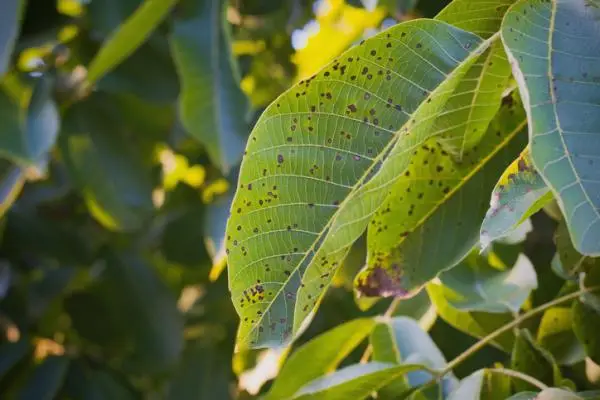Fungal pests cause huge economic losses every year in all types of crops. Fighting them is not always easy and, in many cases, the only possible solution is to destroy all infected plants or crops.
This time we are going to talk about anthracnose or fungal leaf spot, a disease caused by one of the most dangerous and widespread fungi, especially in hot and humid areas. If you want to learn more about what anthracnose is and its treatment , among other details, join us in this article.
What is anthracnose
Also called canker or canker , anthracnose is a disease symptom of plants affected by fungi of the genera Gloeosporium, Collectotrichum, and Coniothyrium fuckelii.
It usually occurs in tropical climates, with high temperatures and humidity, and can be recognized by the brown spots that appear on the leaves of the plants, around the nerves. They start out as small, circular spots that darken and become necrotic. In addition to heat and humidity levels above 90%, one of the most common causes of its appearance is the suffering of wounds on the part of the plant, either due to careless pruning, blows or insect attack .
Regarding which crops are the most prone to its attack, mainly citrus fruits, olive trees and some vegetables can be found. In this way, it is not difficult to see symptoms of anthracnose in mango, avocado, tomato, papaya or even in coffee.
It is rare that anthracnose can cause serious damage in most plant species, but it represents a serious economic loss due to the aesthetic damage it causes to the fruits, which are no longer suitable for sale due to the numerous gray spots that exhibit. Considering this, and the fact that the pest particularly affects farm crops, it is a much more serious problem for farmers than it is for gardening enthusiasts or owners of small orchards.
If your plants have dark-hued marks on the leaves, it may be due to anthracnose, but there are more possible causes.

Symptoms and signs of anthracnose in crops
There are unmistakable signs that plants are suffering from such a fungal infection. So, if you see some of these symptoms of anthracnose on the leaves of your plants, feel free to quickly start taking the measures and treatments that you will see later.
- Round, dark spots on the leaves.
- Rot.
- Decay of the leaves and stems.
- Premature drop of fruits and flowers.
- Round and dark spots on the fruits.
Anthracnose: treatments
There are a large number of measures that can be taken as prevention and treatment to combat the attack of anthracnose . These are some of them:
- Disinfect the soil before planting: the use of ecological fungicides is recommended, although you can also find chemical products in specialized stores. A properly disinfected soil will be much less likely to have the right conditions for the development of anthracnose and other fungi. In addition to applying it as prevention, if these fungi appear, it is best to remove the affected parts (or the entire plant) and apply more fungicide.
- Strive for good drainage – it ‘s difficult to improve drainage in large planting spaces, but if it’s a small garden, you should put some energy into making sure your soil has the best possible drainage. In addition, accumulations of water and ponding are not only an excellent breeding ground for these fungi, but are also detrimental to the vast majority of crops.
- Separate your crops well: if the weather forecast announces a rainy season and with high temperatures, try to space your planting frames from each other. Thus, if one of them becomes infected, you will at least make it difficult for the fungus to spread to the adjacent ones.
- Remove weeds: The removal of adventitious plants, commonly called “weeds,” can also be very helpful in preventing anthracnose. Since its fungi can spread on all kinds of plants and grasses, even lawns can be a surface to spread on. Keeping the soil free of adventitious plants will slow down the spread of the fungus, and therefore you will be able to locate and isolate the focus earlier.
- Eliminate damaged plants: once you locate the infected source, leave no remains. Remove the affected plants and dispose of their debris completely.
- Do not wet the leaves: if you can avoid it, try not to wet the aerial part of the plants. The leaves, stems and flowers are especially susceptible to fungal attack when they are constantly humid. A direct irrigation system to the ground is more recommended.
- Avoid monoculture: this is a very beneficial measure against all types of pests, and not only against anthracnose. In addition, by using various crops you reinforce the beneficial microorganisms in the soil, which help keep fungi and harmful elements at bay.
- Disinfect pruning tools: this is another practice that is always recommended, but is especially important in these cases. Disinfect with alcohol both before and after pruning.

